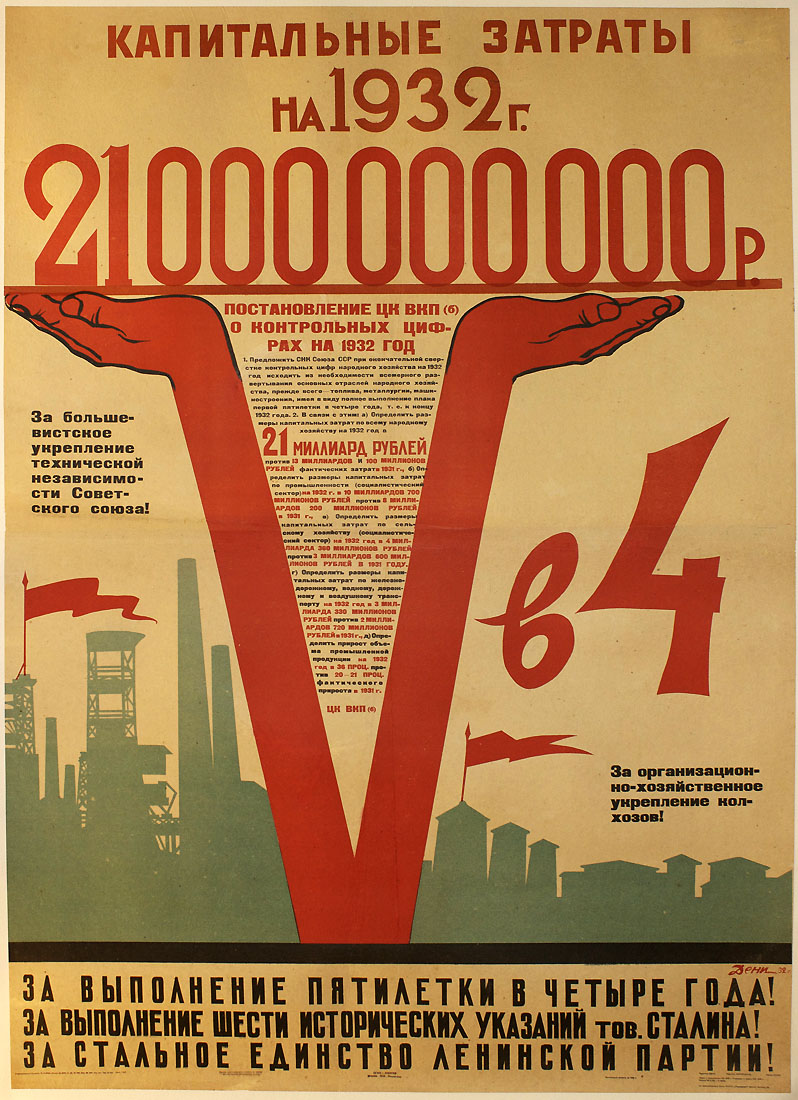
Capital Expenses For The Year 1932. 21,000,000,000 rubles [Partial translation]
Poster Number: PP 463
Category: Economy
Poster Notes: Poster is oversized; [Left side text]: For Bolshevik strengthening of the technical independence of the Soviet Union!; [Right side text] For strengthening of the economic organization of collective farms!
Media Size: 58x42
Poster Type: Lithograph
Publishing Date: 1932
Editorial Information: Editor Korobchenko; Technical Editor Gusev
Technical Information on Poster: Izogiz No. 3570; Second edition; I. 30. No. 645; Submitted for production February 9, 1932; Approved for printing February 10, 1932; Size 82 x 110; Volume 2 sheets; Order No. 399; [Printed at] 28 Valovaia Street; Send your comments about this poster to the address: Mass Agitation Dep
Print Run: 10,000
Glavlit Directory Number: B-17430
Catalog Notes: PP 463 Economy (oversized)
Artist: Deni (Denisov), Viktor Nikolaevich — Дени (Денисов), Виктор Николаевич
Although known for his characterizations and posters that he signed with the pseudonym 'Deni'; Viktor Nikolayevich Denisov never received formal artistic education. Around 1906, Deni began exhibiting at the annual exhibitions of the Society of Independents in Saint Petersburg, as well as at the Salon of Humorists. In 1910, he took private lessons in painting and drawing from the artist-portraitist Nikolai P. Ulianov and that same year, he became active in the field of political caricature, contributing ...
Read More About This Artist
Printer: 1st Exemplary Ogiz RSFSR Typography Workshop of the Poligrafkniga Trust, Moscow — 1-я Образцовая типография Огиза РСФСР треста Полиграфкнига, Москва
1st Exemplary Ogiz RSFSR Typography Workshop of the Poligrafkniga Trust was located in Moscow at 28 Valovaia Street. Historically, the workshop began as the Sharapov-Sytin Partnerhip in the era prior to the Russian Revolution. Ivan Dmitrievich Sytin (1851-1934) was the son of a peasant. He opened a small print shop in Moscow using a single press and by the start of the 20th century his printing business (at Valovaia and Piatnitskaia streets) was the largest private ...
Read More About This Printer
Publisher: IzoGiz (State Publishing House of Fine Art), Moscow — Изогиз (Государственное издательство изобразительного искусства), Москва
The history of IzoGiz begins with the formation of Ogiz, the Association of the State Book and Magazine Publishers. In 1930, the Sovnarkom of the Russian Socialist Federative Soviet Republic established Ogiz to centralize publishing under a monopoly in order to eliminate duplication of printed material, to streamline and control publishing production and its output, and to create a base for marketing books, training and technical manuals. In 1931, the Central Committee of the USSR ordered certain ...
Read More About This Publisher